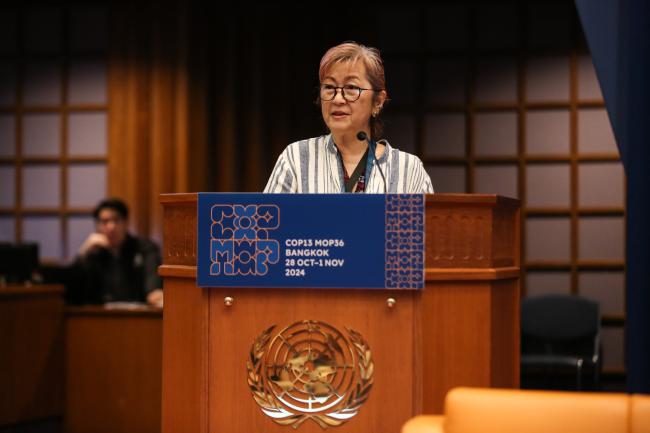Workshop on life-cycle refrigerant management
The leakage, loss and inefficient use of refrigerants contribute to ozone depletion in the stratosphere and to climate change. So far, solutions to these challenges have been insufficient. To bridge this gap, parties to the Montreal Protocol called for a workshop to address life-cycle refrigerant management (LRM) in advance of the thirty-sixth Meeting of the Parties (MOP36).
Megumi Seki, Executive Secretary, Ozone Secretariat, opened the workshop, acknowledging the report on LRM by the Technology and Economic Assessment Panel (TEAP) Task Force. Liazzat Rabbiosi, Ozone Secretariat, noted that outcomes from the workshop would be reported to MOP36.
Introducing LRM as the comprehensive approach to managing refrigerants in the lifecycle of the refrigeration, air conditioning, and heat pump (RACHP) sectors, Hilde Dhont, TEAP Task Force, identified the LRM practices of leakage prevention, recovery, reuse, and destruction. She noted that the TEAP Task Force Report on LRM highlighted key findings including that LRM technologies are not always accessible and that data collection systems could inform parties’ LRM strategies.
Country experiences with LRM
Irene Papst, Climate and Ozone Protection Alliance, presented policy options on LRM implementation and explained how a reverse supply chain and extended producer responsibility (EPR) can be effective approaches to managing refrigerants.
Panelists sharing country experiences with LRM illustrated how:
-
challenges with illegal release detection, small business awareness, and accurate data collection remain in Japan despite the clear regulatory framework in place;
-
in Australia, a coordinated approach with industry and a ban on non-refillable cylinders has greatly advanced LRM objectives;
-
successful regional legislation in the EU includes rules for emission prevention requirements; recovery obligations; destruction; producer responsibility schemes; and certifications requirements for technicians;
-
continuous emissions monitoring schemes in Ghana will be in place in 2025 to allow for reporting and environmentally sound management (ESM), and the destruction of refrigerants, refrigerant oils, and hazardous e-waste fractions;
-
a combined approach of regulatory and voluntary measures on a “learning-by-doing" basis has strengthened the LRM framework in the US, including a partnership programme with supermarkets and public grants for hydrofluorocarbon (HFC) reclamation and destruction technologies;
-
export restrictions for hazardous materials and international funding support have helped Mexico develop alternative refrigerant waste destruction methods; and
-
a unified certification system for technicians in India helps address the challenges related to the complex design of equipment, dismantling, and recovery of refrigerants.
Parallel deep dive sessions into LRM
Leak prevention
Participants heard that to be effective, refrigerant leak prevention must occur at all stages of design, manufacture, transport and storage, installation, commission, use, service, and end-of-life of equipment. Prevention efforts must be deployed through direct gas detection, which ideally is automated, but also indirect methods based on identifying abnormal system performance. The discussion included measures to prevent leakage in challenging conditions such as salty or heavily polluted air. The regulatory framework was also highlighted as a key element, with licenced technicians being trained, audited, and sanctioned appropriately.
Recovery, recycling and reclamation
The recovery, recycling, and reclamation (RRR) of refrigerants was debated against the concept of a “reverse supply chain” with multiple challenges. Economic barriers include fluctuating refrigerant prices and RRR costs often exceeding virgin refrigerant costs. Technical obstacles remain, particularly in Article 5 countries where RRR technologies are often not accessible, affordable, or implementable. Quality challenges include the need for sophisticated and expensive laboratory analysis. In addition, the enforcement of regulatory frameworks is a challenge in itself with a large number of often small businesses involved.
Destruction of refrigerants
On the challenges related to refrigerant destruction, participants identified inadequate financial resources and the lack of both infrastructure and technology. On solutions for the ESM of refrigerant waste, participants identified the importance of: strengthening national regulations and enforcement; enhancing financial incentives from the Multilateral Fund; and promoting the use of the best available technologies. Participants also discussed: the need for cooperation with the Basel and Bamako conventions to address transboundary movement of equipment set for destruction; the lack of destruction facilities in most Article 5 countries; and how to ensure destruction is environmentally sound and economically effective.
Dealing with equipment
Participants heard from the Basel, Rotterdam, and Stockholm Conventions Secretariat, who provided information on the Partnership for Action on Challenges relating to E-Waste (PACEII). The Partnership has expanded to include the development of guidance documents on the ESM of used and waste RACHP equipment, for which participants considered: how to create a circular economy for refrigerant-containing equipment; control measures for the transboundary movement of e-waste; the need for cooperation between the Basel Convention and the Montreal Protocol to manage RAC equipment; and the need for industry to pay into a global EPR fund.
Financing life-cycle refrigerant management
Bassam Elassaad, TEAP Task Force, presented the cost and resource analysis of LRM practices and available financing options, highlighting EPR, tax measures, and carbon credit schemes as LRM financing options. Panelists discussed the need for a long-term LRM investment in developing countries and a clear definition of stakeholders in LRM. They also considered the pros and cons of HFC tax refund schemes and the cost implications of implementing LRM in low-volume-consuming countries (LVCs). They further discussed an industry-managed EPR programme to ensure the environmentally sound destruction of refrigerants; the benefits of public-private partnerships for LRM investments in LVCs; and the growing awareness of LRM among consumers which could drive demand for reclaimed refrigerants over virgin material.
To receive free coverage of global environmental events delivered to your inbox, subscribe to the ENB Update newsletter.
All ENB photos are free to use with attribution. For the 2024 UN Biodiversity Conference, please use: Photo by IISD/ENB | Natalia Mroz

























